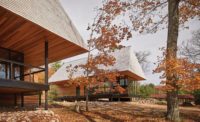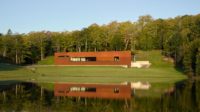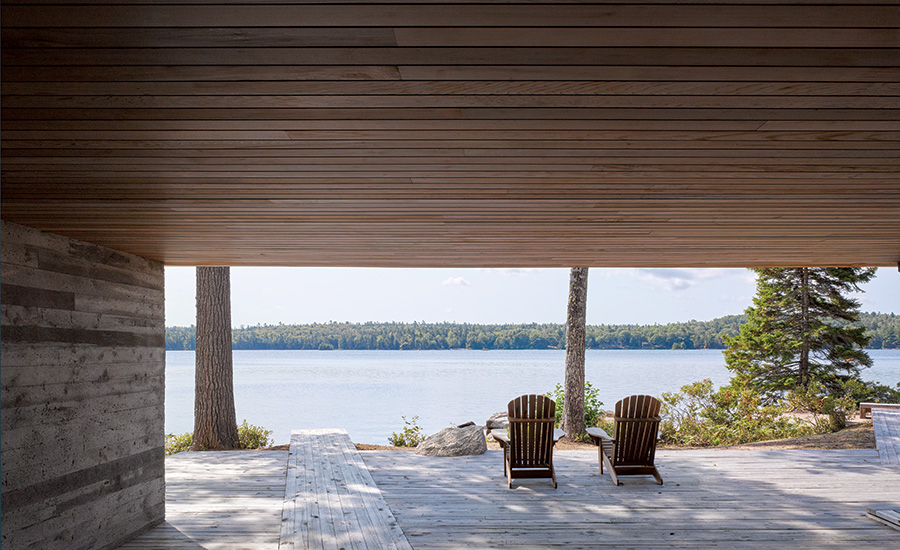Mirror Point Cottage by MacKay-Lyons Sweetapple Architects
Annapolis Royal, Nova Scotia

Mirror Point Cottage
The Eastern white cedar– shingled house sits among spruce, pine, and oak trees on the shores of Grand Lake in Nova Scotia’s Annapolis County. Its simple form is a nod to the “Newfie Box” of the area.
Photography © James Brittain

Mirror Point Cottage
The 80-foot-long house is essentially an extrusion of its gabled front, with the main entrance below the elevated structure.
Photo © James Brittain

Mirror Point Cottage
A sunken area serves as a summer kitchen.
Photo © James Brittain

Mirror Point Cottage
An operable clerestory along the entire northern facade provides natural ventilation.
Photo © Will Green

Mirror Point Cottage
Framed views of the lake.
Photo © James Brittain

Mirror Point Cottage
The gang-nail roof truss, normally hidden, is exposed and painted white, along with the pine planks of the main walls and sloping ceiling.
Photo © James Brittain

Mirror Point Cottage
The cabinetry of the kitchen and fireplace in the main living space is clad in the same Western red cedar that sheathes the staircase.
Photo © James Brittain

Mirror Point Cottage
Image courtesy MacKay-Lyons Sweetapple Architects

Mirror Point Cottage
Image courtesy MacKay-Lyons Sweetapple Architects

Mirror Point Cottage
Image courtesy MacKay-Lyons Sweetapple Architects










Architects & Firms
The biggest decision about the design of the house on Grand Lake in Nova Scotia, along Canada’s Atlantic coast, says architect Brian MacKay-Lyons, was to elevate it. That singular move solved a number of issues related to site and function, and turned a modest house modeled after the traditional cabins that dot this picturesque landscape into a subtle architectural achievement.
Additional Information:Jump to People/Products
The lofty abode, arrived at after driving more than a mile over a narrow, twisting pathway off a main road, takes on a monumental presence as it finally reveals itself among a forest of evergreens. Anticipation similarly builds on the way into the house. Passing beneath the raised portion of the building to low, framed views of the lake, one immediately turns to ascend a slender, enclosed wood-clad staircase before reaching the open glass-walled main living space and its unobstructed panorama. Says MacKay-Lyons, “There’s a choreography about the entry that is important.”
Built as a vacation house for a local fisherman’s daughter who resides primarily in London with her Dutch husband and two young children, the design combines vernacular influences with an equally strong contemporary aesthetic, and accommodates the needs of the three generations of this family who spend summers and winter holidays here.
The form of the building is immediately recognizable in these parts as a “Newfie box,” a popular typology thought to have been brought over by fishermen and shipbuilders from nearby Newfoundland. The simple structure comprises a low-pitched gable carved into a 16-by-16- foot square.
This particular version features a slightly deeper angle to the roof, and is extruded 80 feet along the east–west axis to maximize solar gain. An operable clerestory runs along the entire length of the northern facade, providing natural ventilation in tandem with the sliding glass doors of the south facade, while also offering two kinds of light— north and south—throughout the long, linear space. (Low glass partitions on the south facade, practically invisible, serve as balustrades when the doors are open.) Its clever layout tucks in a kitchen, fireplace, staircase, and closets—all clad in Western red cedar—along the solid, heavily insulated northern wall, with living and dining spaces, two bedrooms, and a bath facing the lake. “The house is essentially a giant porch,” its architect explains.
The small board-formed-concrete bunker beneath the main level contains a guest bedroom and an additional bathroom, as well as a very minimal mechanical closet. (Hydronic heating within the high-thermal mass concrete floors is powered electrically.) Beside the bunker—which, together with the steel bracing above it, makes up the house’s structural core—is the summer kitchen.
That sunken area is defined by the four steel posts that help support the suspended living area and was designed, in part, with the grandparents in mind. “They visit often,” says MacKay-Lyons. “They can cook and eat and relax here in the shade without climbing up and down the stairs, while keeping an eye on the kids when they’re swimming in the lake.”
The timber for the deck and walkways around the pit is a local hemlock, the “poor man’s cedar,” according to MacKay-Lyons, who designs with economy as an ethic, irrespective of a client’s pocketbook. He and his Halifax-based firm, MacKay-Lyons Sweetapple Architects, have completed over 80 residential projects in the area, including the dramatic Cliff House (RECORD, October 2013, page 33), defining a Nova Scotia modernism in the process.
Inside this house, the most striking feature is the series of gangnail trusses that supports the roof. A commonplace structural system that is typically hidden, MacKay-Lyons here exposes the 17 pairs of trusses—spaced 5 feet apart and fitted together with plates of galvanized sheet metal—to great effect. “To create certain kinds of luxury, other things need to be cheap,” he explains. “The trusses were cheap, the vast expanse of glass was a luxury.”
MacKay-Lyons not only looks to vernacular architecture but to the traditions of the region—in this case, those of the shipbuilding history of the Maritimes. He lined the underside of the building in cedar that is reminiscent of the hull of a ship. Distinct elements, including the gate to the property and a walkway off the main bedroom—the eastern end of the building almost touching grade— are made from rusted steel, like that found in old shipyards.
On the inside, the pine planks of the walls and sloping ceilings, and the solid wood two-by-fours of the trusses are painted white. Sparse furnishings and decor adhere to the minimal aesthetic, allowing the bucolic backdrop to take center stage. Says the architect, “We wanted to provide the widest range of experience in the simplest package.”
PeopleArchitect: MacKay-Lyons Sweetapple Architects
Engineers: Campbell Comeau Engineering (structural)
Consultants: Scott Shearer Contracting
General contractor: Bulley & Andrews
Size: 2,450 square feet
Cost: withheld
Completion date: November 2014 |
ProductsMetal Roofing: Firestone
Entrances and Metal Window Frames: Comdoor
Glass: PPG
Sliding Doors: Arcadia
Interior Ambient Lighting: Sistemalux
Task Lighting: Artemide
Dimming and Controls: Lutron |















